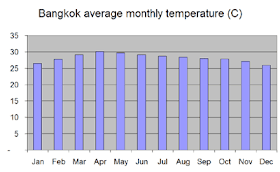Thailand can best be described as tropical and humid for the majority of the country during most of the year. The area of Thailand north of Bangkok has a climate determined by three seasons whilst the southern peninsular region of Thailand has only two.
In northern Thailand the seasons are clearly defined. Between November and May the weather is mostly dry, however this is broken up into the periods November to February and March to May. The later of these two periods has the higher relative temperatures as although the northeast monsoon does not directly effect the northern area of Thailand, it does cause cooling breezes from November to February.
The other northern season is from May to November and is dominated by the southwest monsoon, during which time rainfall in the north is at its heaviest.
The southern region of Thailand really has only two seasons -- the wet and the dry. These seasons do not run at the same time on both the east and west side of the peninsular. On the west coast the southwest monsoon brings rain and often heavy storms from April through to October, whilst on the east coast the most rain falls between September and December.
Overall the southern parts of Thailand get by far the most rain with around 2,400 millimetres every year, compared with the central and northern regions of Thailand, both of which get around 1,400 millimetres.
When is the best time to visit Thailand?
Generally speaking,the best time to visit Thailand is from November to February when the northeast monsoon is blowing cool, dry air which serves as a respite from the heat. During this cool season, the temperature ranges from 18ºC to 32ºC in Bangkok, while in northern and northeast Thailand, temperatures can get quite cool with morning temperatures as low as 8º C to 12º C with the occasional 20º C day. Nights can be particularly chilly and at high altitudes the temperatures can and do drop below freezing.The summer period, or hot and dry season, is from March to June. At this time temperatures in Bangkok average around 34º C, but can often reach 40º C with the humidity levels of 75%.
Try and avoid April, unless you plan to be permanently submerged in the ocean, because this is the hottest month across the country.
From July to October is the monsoonal season when most of Thailand's annual rainfall is accumulated. The humidity averages just under 90%, with temperatures averaging around 29º C in Bangkok.
The monsoons finish when the wind direction changes, bringing dry weather from the northeast. At best this season can be described as unpredictable and not the constant downpour of rain like you would expect. The middle months of this season may hold particularly heavy rains for the north of the country.
Central Thailand: Bangkok


Central Thailand: Ko Chang


Northern Thailand: Chiang Mai


Northeastern Thailand: Udon Thani


Northeastern Thailand: Buriram


South-east Thailand: Ko Samui


South-west Thailand: Phuket


South-west Thailand: Ko Lanta


South-west Thailand: Trang

